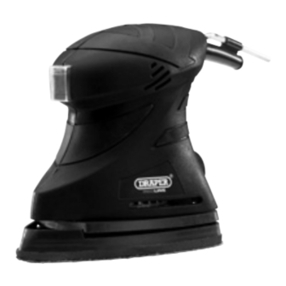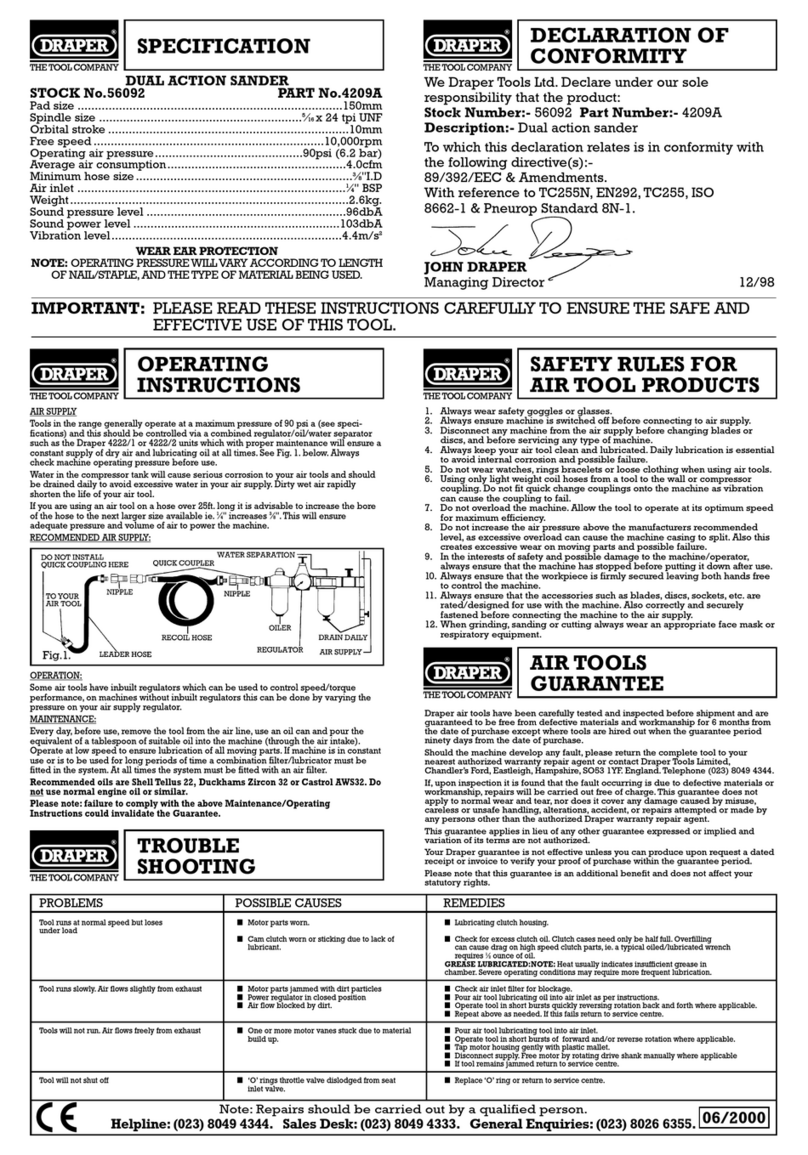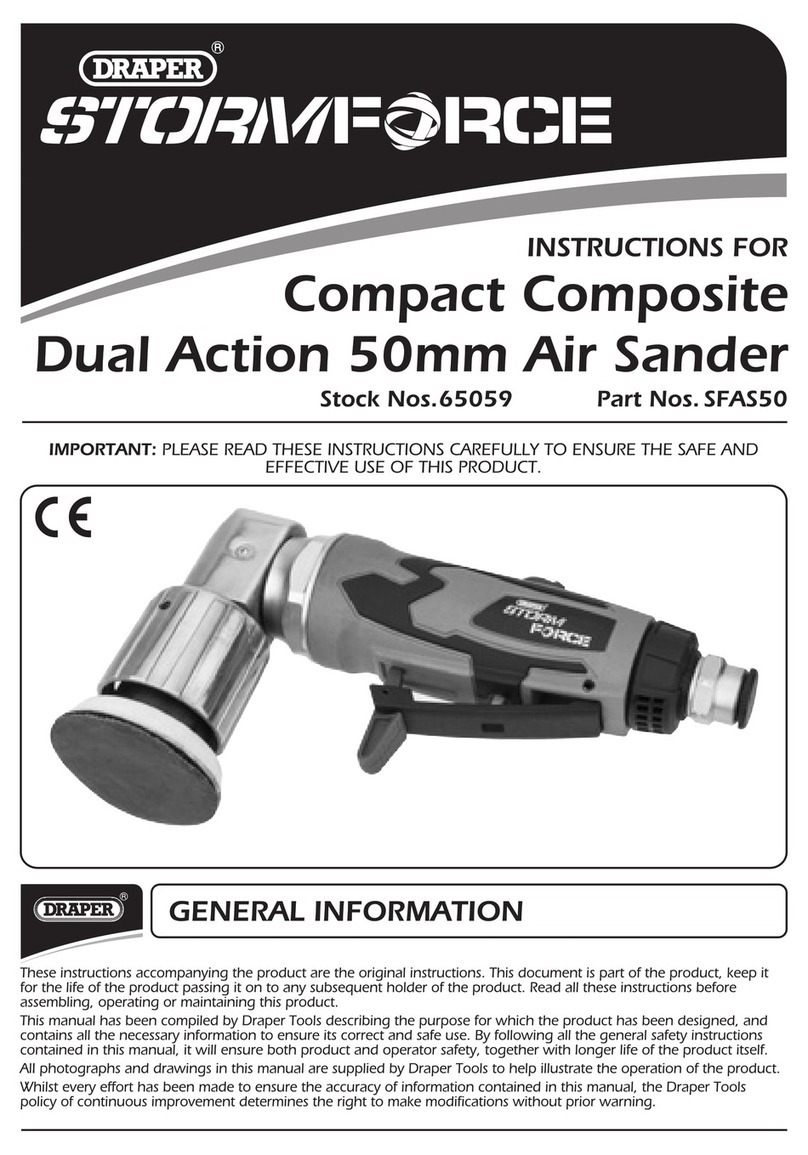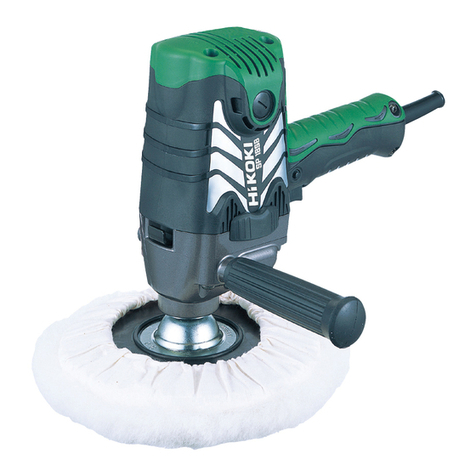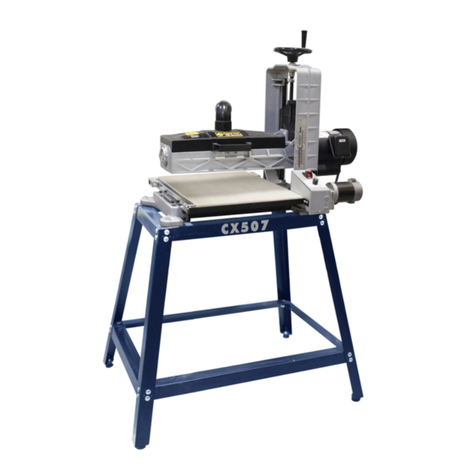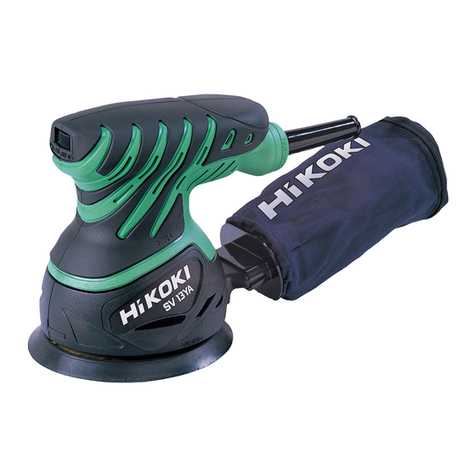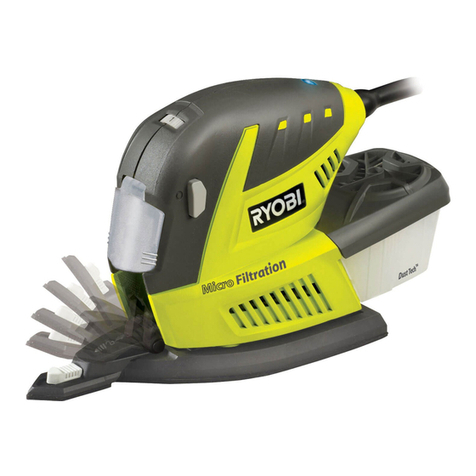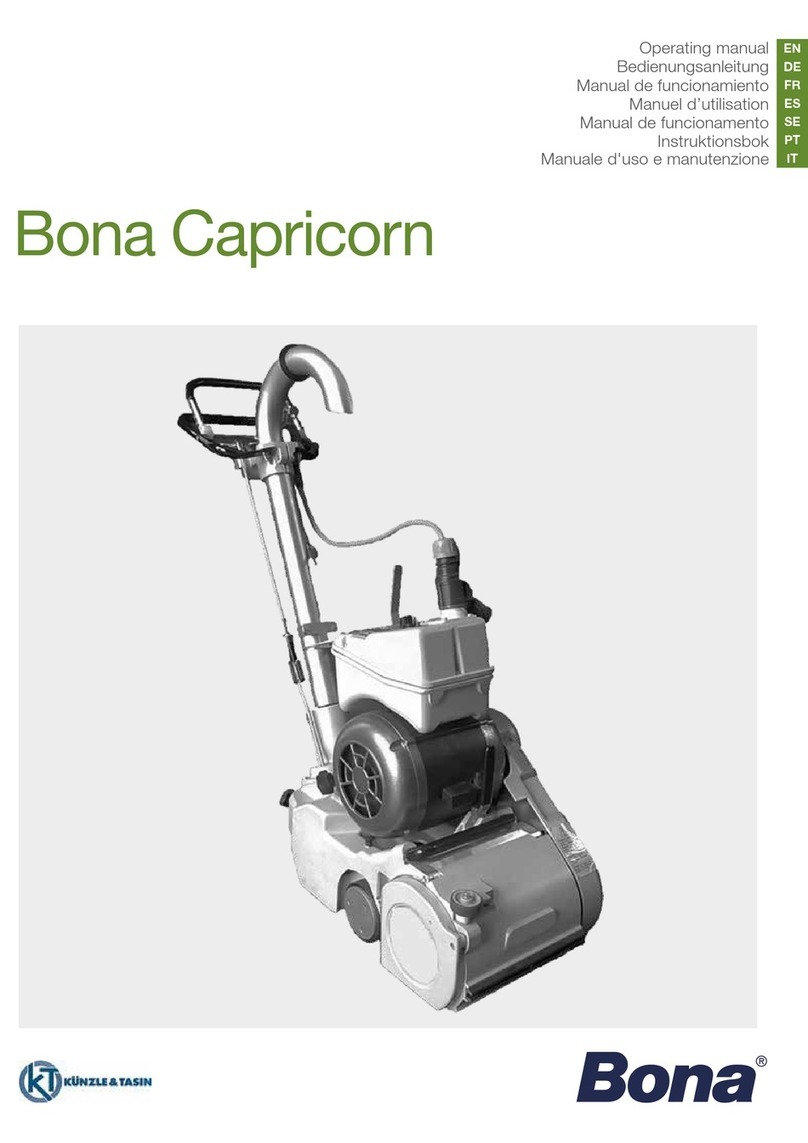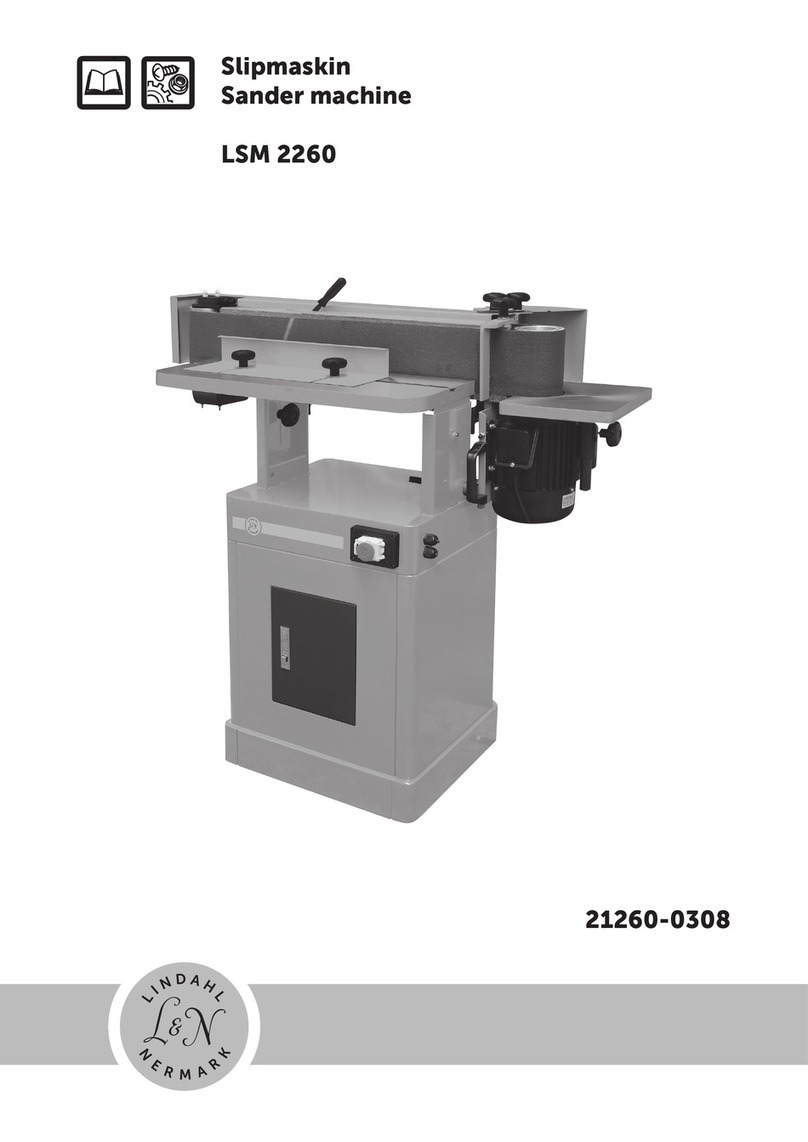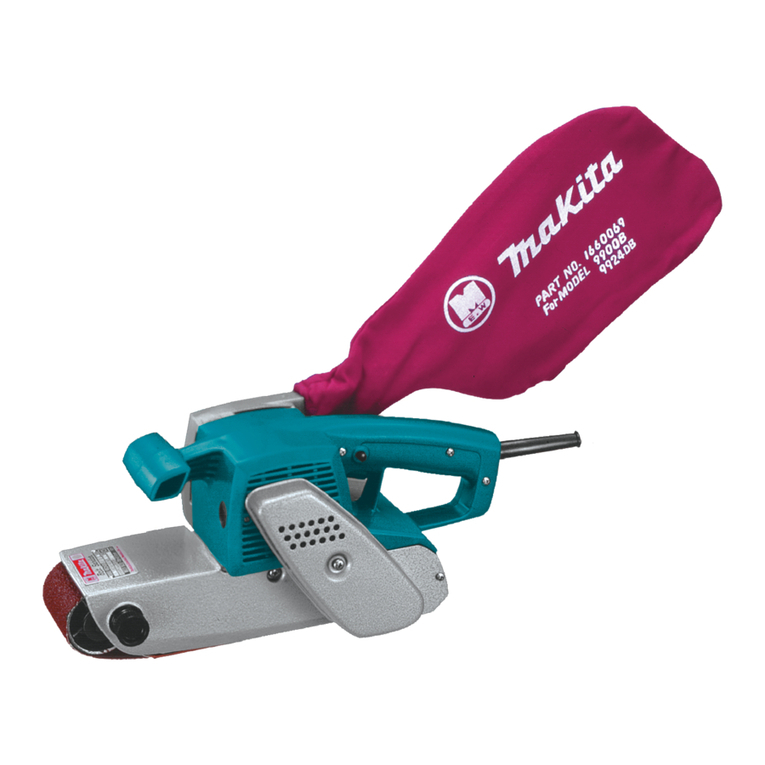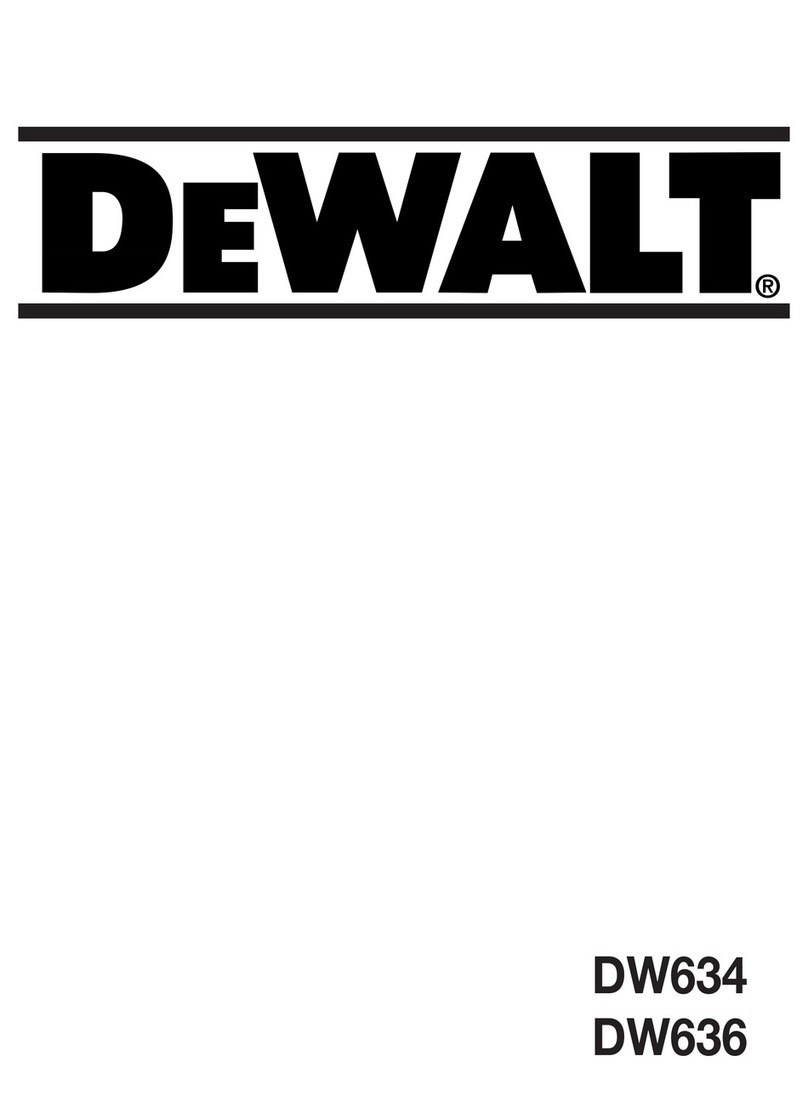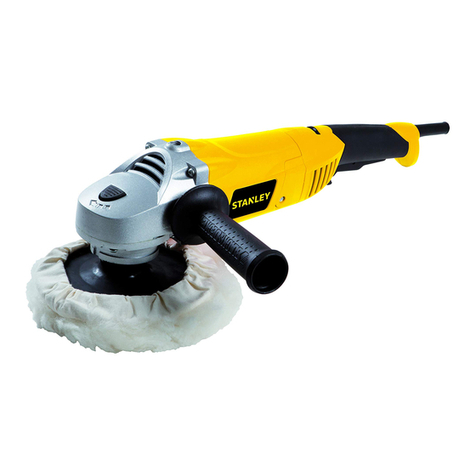Draper 56490 User manual

230V
MINI BELT
SANDER
56490
These instructions accompanying the product are the original instructions. This document is part of the product, keep
it for the life of the product passing it on to any subsequent holder of the product. Read all these instructions before
assembling, operating or maintaining this product.
This manual has been compiled by Draper Tools describing the purpose for which the product has been designed,
and contains all the necessary information to ensure its correct and safe use. By following all the general safety
instructions contained in this manual, it will ensure both product and operator safety, together with longer life of the
product itself.
AlI photographs and drawings in this manual are supplied by Draper Tools to help illustrate the operation of the
product.
Whilst every effort has been made to ensure the accuracy of information contained in this manual, the Draper Tools
policy of continuous improvement determines the right to make modifications without prior warning.

1. TITLE PAGE
1.1 INTRODUCTION:
USER MANUAL FOR: 230V Mini Belt Sander
Stock No: 56490
Part No: BS400D13
1.2 REVISIONS:
Date first published April 2019.
Date of first revision: November 2019.
Date of second revision: July 2022.
As our user manuals are continually updated, users should make sure that they use
the very latest version.
Downloads are available from: http://www.drapertools.com/manuals
Draper Tools Limited Delta International
Hursley Road Delta International BV
Chandler’s Ford Oude Graaf 8
Eastleigh 6002 NL
Hampshire Weert
SO53 1YF Netherlands
UK
Website: Drapertools.com
Product Help Line: +44 (0) 23 8049 4344
General Fax: +44 (0) 23 8026 0784
1.3 UNDERSTANDING THIS MANUALS SAFETY CONTENT:
WARNING! - Information that draws attention to the risk of injury or death.
CAUTION! - Information that draws attention to the risk of damage to the product or
surroundings.
1.4 COPYRIGHT © NOTICE:
Copyright © Draper Tools Limited.
Permission is granted to reproduce this publication for personal & educational use
only. Commercial copying, redistribution, hiring or lending is prohibited.
No part of this publication may be stored in a retrieval system or transmitted in any
other
form or means without written permission from Draper Tools Limited.
In all cases this copyright notice must remain intact.

2. CONTENTS
1. TITLE PAGE
1.1 INTRODUCTION ............................................................................................................. 2
1.2 REVISION HISTORY ...................................................................................................... 2
1.3 UNDERSTANDING THIS MANUAL ............................................................................... 2
1.4 COPYRIGHT NOTICE..................................................................................................... 2
2. CONTENTS
2.1 CONTENTS..................................................................................................................... 3
3. WARRANTY
3.1 WARRANTY.................................................................................................................... 4
4. INTRODUCTION
4.1 SCOPE............................................................................................................................ 5
4.2 SPECIFICATION ............................................................................................................. 5
4.3 HANDLING & STORAGE ................................................................................................ 5
5. HEALTH AND SAFETY INFORMATION
5.1 GENERAL SAFETY INSTRUCTIONS FOR POWER TOOL USE .................................. 6
5.2 ADDITIONAL SAFETY INSTRUCTIONS FOR SANDERS ............................................. 7
5.3 RESIDUAL RISK ............................................................................................................. 7
5.4 CONNECTION TO THE POWER SUPPLY..................................................................... 8
6. TECHNICAL DESCRIPTION
6.1 IDENTIFICATION ............................................................................................................ 9
7. UNPACKING AND CHECKING
7.1 PACKAGING ................................................................................................................. 10
7.2 WHAT’S IN THE BOX.................................................................................................... 10
8. ASSEMBLY
8.1 FITTING THE SANDING HEAD .....................................................................................11
8.2 FITTING OR REPLACING THE SANDING BELT......................................................... 12
8.3 SANDING BELT TRACKING AND ADJUSTMENT........................................................ 12
8.4 FITTING THE DUST EXTRACTION BAG..................................................................... 13
9. BASIC SANDING OPERATIONS
9.1 POSITIONING THE SANDING ARM............................................................................. 14
9.2 TRIGGER SWITCH ....................................................................................................... 14
9.3 VARIABLE SPEED CONTROL...................................................................................... 14
9.4 GENERAL SANDING INFORMATION .......................................................................... 15
10. MAINTENANCE AND TROUBLESHOOTING
10.1 MAINTENANCE ............................................................................................................ 16
10.2 TROUBLESHOOTING .................................................................................................. 16
11. OPTIONAL ACCESSORIES
11.1 OPTIONAL ACCESSORIES.......................................................................................... 17
12. DISPOSAL
12.1 DISPOSAL..................................................................................................................... 18
13. EXPLANATION OF SYMBOLS
13.1 EXPLANATION OF SYMBOLS ..................................................................................... 19
DECLARATION OF CONFORMITY .............................................................................. ENCLOSED
- 3 -

3. WARRANTY
3.1 WARRANTY
Draper tools have been carefully tested and inspected before shipment and are guaranteed to be
free from defective materials and workmanship.
Should the tool develop a fault, please return the complete tool to your nearest distributor or
contact
Draper Tools Limited, Chandler's Ford, Eastleigh, Hampshire, SO53 1YF. England.
Telephone Sales Desk: (023) 8049 4333 or Product Help Line (023) 8049 4344.
A proof of purchase must be provided with the tool.
If upon inspection it is found that the fault occurring is due to defective materials or workmanship,
repairs will be carried out free of charge. This warranty period covering parts and labour is 12
months from the date of purchase except where tools are hired out when the warranty period is 90
days from the date of purchase. This warranty does not apply to any consumable parts, any type
of battery or normal wear and tear, nor does it cover any damage caused by misuse, careless or
unsafe handling, alterations, accidents, or repairs attempted or made by any personnel other than
the authorised Draper warranty repair agent.
Note: If the tool is found not to be within the terms of warranty, repairs and carriage charges will
be quoted and made accordingly.
This warranty applies in lieu of any other warranty expressed or implied and variations of its terms
are not authorised.
Your Draper warranty is not effective unless you can produce upon request a dated receipt or
invoice to verify your proof of purchase within the warranty period.
Please note that this warranty is an additional benefit and does not affect your statutory rights.
Draper Tools Limited.
- 4 -

4. INTRODUCTION
4.1 SCOPE
A narrow belt sander designed to access “hard to reach” areas where a traditional sander could
not access.
As part of our core range, this product is suitable for enthusiasts and tradespeople alike. Any
application other than that it was intended for, is considered misuse.
4.2 SPECIFICATION
Stock No................................................................................................................................... 56490
Part No. .............................................................................................................................BS400D13
Motor:
Rated voltage ................................................................................................................ 230V~
Rated frequency .............................................................................................................. 50Hz
Rated input .................................................................................................................... 400W
Belt speed (no load) ..................................................................................... 300 – 1700M/min
Belt width ................................................................................................................................. 13mm
Belt length ............................................................................................................................. 457mm
Sound pressure level (LpA)*: ........................................................................................... 80.2dB(A)
Sound power level (LWA)**: .............................................................................................. 91.2dB(A)
Vibration level†:................................................................................................ 1.215m/s², K=1.5m/s2
Weight (machine only)................................................................................................................. 2kg
* Continuous A-Weighted Sound Pressure Level at the workstation in accordance to and declared
according to EN60745.
** The typical A-weighted noise level determined according to EN60745.
†When sanding in wood.
4.3 HANDLING AND STORAGE
– Care must be taken when handling this product.
●Dropping this power tool could have an effect on its accuracy and could also result in
personal injury. This product is not a toy and must be respected.
– Environmental conditions can have a detrimental effect on this product if neglected.
●Exposure to damp air can gradually corrode components.
●If the product is unprotected from dust and debris, components will become clogged.
●If not cleaned and maintained correctly or regularly, the machine will not perform at its best.
- 5 -

5. HEALTH AND SAFETY INFORMATION
5.1 GENERAL SAFETY INSTRUCTIONS FOR POWER TOOL USE
When using any type of power tool there are steps that should be taken to make sure that you, as the
user, remain safe.
Common sense and a respect for the tool will help reduce the risk of injury.
Read the instruction manual fully. Do not attempt any operation until you have read and understood
this manual.
Most important you must know how to safely start and stop this machine, especially in an emergency.
Keep the work area tidy and clean. Attempting to clear clutter from around the machine during use
will reduce your concentration. Mess on the floor creates a trip hazard. Any liquid spilt on the floor
could result in you slipping.
Find a suitable location. If the machine is bench mounted, the location should provide good natural
light or artificial lighting as a replacement. Avoid damp and dust locations as it will have a negative
effect on the machine’s performance. If the machine is portable do not expose the tool to rain. In all
cases do not operate power tools near any flammable materials.
Keep bystanders away. Children, onlookers and passers by must be restricted from entering the work
area for their own protection. The barrier must extend a suitable distance from the tool user.
Unplug and house all power tools that are not in use. A power tool should never be left unattended
while connected to the power supply. They must be housed in a suitable location, away locked up and
from children. This includes battery chargers.
Do not overload or misuse the tool. All tools are designed for a purpose and are limited to what they
are capable of doing. Do not attempt to use a power tool (or adapt it in any way) for an application it is
not designed for. Select a tool appropriate for the size of the job. Overloading a tool will result in tool
failure and user injury. This covers the use of accessories.
Dress properly. Loose clothing, long hair and jewellery are all dangerous because they can become
entangled in moving machinery. This can also result in parts of body being pulled into the machine.
Clothing should be close fitted, with any long hair tied back and jewellery and neck ties removed.
Footwear must be fully enclosed and have a non-slip sole.
Wear personal protective equipment (PPE). Dust, noise, vibration and swarf can all be dangerous if
not suitably protected against. If the work involving the power tool creates dust or fumes wear a dust
mask. Vibration to the hand, caused by operating some tools for longer periods must be protected
against. Wear vibration reducing gloves and allow long breaks between uses. Protect against dust and
swarf by wearing approved safety goggles or a face shield. These are some of the more common
hazards and preventions, however, always find out what hazards are associated with the
machine/work process and wear the most suitable protective equipment available.
Do not breathe contaminated air. If the work creates dust or fumes connect the machine (if possible)
to an extraction system either locally or remotely. Working outdoors can also help if possible.
Move the machine as instructed. If the machine is hand held, do not carry it by the power supply
cable. If the product is heavy, employ a second or third person to help move it safely or use a
mechanical device. Always refer to the instructions for the correct method.
Do not overreach. Extending your body too far can result in a loss of balance and you falling. This
could be from a height or onto a machine and will result in injury.
Maintain your tools correctly. A well maintained tool will do the job safely. Replace any damaged or
missing parts immediately with original parts from the manufacturer. As applicable, keep blades sharp,
moving parts clean, oiled or greased, handles clean, and emergency devices working.
Wait for the machine to stop. Unless the machine is fitted with a safety brake, some parts may
continue to move due to momentum. Wait for all parts to stop, then unplug it from the power supply
before making any adjustments, carrying out maintenance operations or just finishing using the tool.
- 6 -

5. HEALTH AND SAFETY INFORMATION
5.2 ADDITIONAL SAFETY INSTRUCTIONS FOR SANDERS
Important:
Draper Tools Limited recommends that this machine should not be modified or used for
any application other than that for which it was designed. If you are unsure of its relative
applications do not hesitate to contact us in writing and we will advise you.
Warning!
Some materials may contain toxic chemicals that sanding operations would disturb e.g.
lead painted surfaces. Exposure to these compounds can endanger the health of the operator or
bystanders. It is important that you wear appropriate safety equipment to protect yourself from
exposure to these substances. If in doubt, consult a professional.
Take care to adequately ventilate the work area and take steps to exclude or protect anybody
working in the vicinity.
– Always wear a dust mask and suitable eye protection with sanders.
– Connect dust extraction equipment. If the tool is provided for the connection of dust extraction
and collecting equipment, ensure these are connected and properly used.
– Ensure that you don’t wear any loose clothing or anything else that could get caught in the
machine during operation.
5.3 RESIDUAL RISK
Important:
Although the safety instructions and operating manuals for our tools contain extensive
instructions of safe working with power tools, every power tool involves a certain residual risk
which can not be completely excluded by safety mechanisms. Power tools must therefore always
be operated with caution!
- 7 -

5.4 CONNECTION TO THE POWER SUPPLY
Caution:
Risk of electric shock. Do not open.
This appliance is supplied with a moulded 3 pin mains plug for your safety. The value of the fuse
fitted is marked on the pin face of the plug. Should the fuse need replacing, ensure the substitute is
of the correct rating, approved to BS1362 and ASTA or BS Kite marked.
ASTA
BSI
The fuse cover is removable with a small plain slot screwdriver. Ensure the fuse cover is replaced
before attempting to connect the plug to an electrical outlet. If the cover is missing, a replacement
must be obtained or the plug replaced with a suitable type.
If a replacement plug is to be fitted this must be carried out by a qualified electrician.
The damaged or incomplete plug, when cut from the cable should be disabled to prevent
connection to a live electrical outlet.
This appliance is Class II†and is designed for connection to a power supply matching that detailed
on the rating label and compatible with the plug fitted.
†Double insulated : This product requires no earth connection as supplementary insulation is
applied to the basic insulation to protect against electric shock in the event of failure of the basic
insulation.
Important:
If using an extension lead, follow the instructions that came with your lead regarding
maximum load while cable is wound. If in doubt, ensure that the entire cable is unwound. Using a
coiled extension lead will generate heat which could melt the lead and cause a fire.
5. HEALTH AND SAFETY INFORMATION
- 8 -

6. TECHNICAL DESCRIPTION
6.1 IDENTIFICATION
- 9 -
Sanding belt (80 grit).
Variable speed.
Switch lock button.
Belt tracking adjustment knob.
Adjustable sanding locking arm lever.
Belt tension release.
Dust extraction port.¬
Trigger switch.
Power cable.
Sanding head.
Sanding arm.

7.1 PACKAGING
Carefully remove the product from the packaging and examine it for any sign of damage that may
have happened during shipping. Lay the contents out and check them against the parts shown
below. If any part is damaged or missing, please contact the Draper Help Line (the telephone
number appears on the Title page) and do not attempt to use the product.
The packaging material should be retained at least during the warranty period, in case the
machine needs to be returned for repair.
Warning!
●Some of the packaging materials used may be harmful to children. Do not leave any of these
materials in the reach of children.
●If any of the packaging is to be thrown away, make sure they are disposed of correctly,
according to local regulations.
7.2 WHAT’S IN THE BOX
As well as the sander, there are several parts not fitted or attached to it.
7. UNPACKING AND CHECKING
- 10 -
Belt tracking adjustment knob.
Sanding head.
Extra spare sanding belt (120 grit).
Belt tracking adjustment spring.
Dust collection bag.

8. ASSEMBLY
8.1 FITTING THE SANDING HEAD –
FIGS.1 – 4
Warning!
Disconnect the machine from the power
supply before carrying out any adjustment,
servicing or maintenance:
– Place the belt tracking adjustment spring
into the locating recess at the front of the
sanding arm
.
– The sanding head
fits onto the sanding
arm
one way only. Align the slot in the side
of the sanding head with the corresponding
ridge located on the sanding arm. Ensure that
the free end of the spring fits over the raised lug
on the sanding head.
– Apply light pressure to compress the spring,
keeping the sanding head engaged with the
sanding arm.
– Fit the belt tracking adjustment knob
into
the screw hole located inside the oval shaped
aperture on the (motor) side of the sanding
arm.
– Tighten the screw, gradually drawing the
sanding head into the body of the sanding arm.
- 11 -
FIG.1
FIG.2
FIG.3
FIG.4

8. ASSEMBLY
8.2 FITTING OR REPLACING THE
SANDING BELT – FIGS.5 – 7
Warning!
Always ensure that the machine is
disconnected from its power source before
attempting to change or replace the sanding belt.
– Pull the belt release lever
(located just
above the belt tracking control knob
)
upwards to release the tension on the belt.
(Fig.5)
– Slide out the belt
to be replaced.
– Refit the required belt over the rear roller
of the sanding arm
and the roller on the
sanding head
(Fig.6).
Note:
Always ensure that the direction of rotation
arrows found on the inside of the belt match the
direction of rotation arrow found on the body of the
machine.
– Return the belt release lever
to its original
position.
8.3 SANDING BELT TRACKING AND
ADJUSTMENT – FIG.8
Warning!
Always wear the appropriate eye safety
protection when carrying out this procedure.
– Plug the machine back into the power supply
and operate the sander while observing the
belt.
– The new belt will have a tendency to track more
to one side. To centre the belt on the rollers and
over the sanding base, rotate belt tracking
control knob
. This pivots the front roller
slightly causing the belt to track across the
roller. Only slight adjustments are needed.
When the belt runs centrally on the rollers it is
adjusted correctly.
- 12 -
FIG.5
FIG.6
FIG.7
FIG.8

8. ASSEMBLY
8.4 FITTING THE DUST EXTRACTION
BAG – FIG.9
Inhalation of dust particles can be detrimental to
health. For this reason a dust extraction bag has
been provided and must be used with the machine
at all times.
Warning!
All wood dust (including dust from
composites like chipboards and fibreboards, etc.) is
hazardous to health; it can affect the nose, the
respiratory system and the skin. For example MDF
(medium density fibreboard) which contains
formaldehyde is a known carcinogen. In addition to
the above measure a correctly fitted dust mask,
suitable for the activity and in accordance to the relevant standard, must be worn.
– The dust bag
is fitted to the sander at the rear by pushing onto the dust extraction port
.
Emptying the dust bag
– Disconnect the plug from the electricity supply.
– Hold your sander vertically with the dust collector at the bottom.
– Pull the bag gently off sander.
– Empty the dust bag by shake out over a bin, then replace on the sander.
– Do not wash the dust bag.
– Empty the dust bag at regular intervals.
- 13 -
FIG.9

9. BASIC SANDING OPERATIONS
9.1 POSITIONING THE SANDING ARM
– FIG.10
The sanding arm can be rotated approximately
120˚in relation to the handle, for operational
convenience and efficiency.
Warning!
Always ensure that the machine is
disconnected from its power source before
attempting to re-position the sanding arm.
To adjust the sanding arm angle:
– Push the sanding arm locking lever
forward
to release the sanding arm.
– Re-position the sanding arm to the required
angle.
– Pull the sanding arm locking lever back to
secure the arm at the new position.
9.2 TRIGGER SWITCH – FIG.11 – 12
Note:
Remove the plug from the socket before
carrying out adjustment, servicing or maintenance.
Prior to connecting this machine to the power
supply ensure the trigger lock is disengaged.
Ensure the sander is raised off the workpiece.
– Press trigger
to start the sander.
– To operate the sander for a prolonged period;
●Press and hold trigger
.
●Press and hold locking button
.
●Release trigger
. Release button
.
– The sander will now continue to run until the
trigger is pressed, automatically releasing
button (Fig.12).
– Wait for complete run-down before putting the
tool aside.
This machine is intended for sanding wood only.
Replace abrasive belts when clogged with material
or when surface/edge has rips, cracks or worn
areas.
Warning!
Hearing protection should be worn when
using belt sanders.
9.3 VARIABLE SPEED CONTROL –
FIG.13
Use the variable speed control dial
to adjust
working speed as appropriate.
- 14 -
FIG.10
FIG.11
FIG.12
FIG.13
120º
APPROX.

9. BASIC SANDING OPERATIONS
9.4 GENERAL SANDING INFORMATION
Select the correct belt grit to obtain the desired finish. The higher the grit number the finer the
finish. For removing large amounts of material a 60/80 grit is ideal. When removing paint from a
wood surface the belt grit will have a tendency to clog.
Replace abrasive belts when clogged with material or when surface/edge has rips, cracks or worn
areas.
Note:
Abrasive belts are a consumable item.
– Always sand along the grain of a workpiece.
– Occasionally check the belt alignment and adjust as necessary.
- 15 -

10. MAINTENANCE AND TROUBLESHOOTING
10.1 MAINTENANCE
Regular inspection and cleaning reduces the necessity for maintenance operations and will keep
your tool in good working condition.
The motor must be correctly ventilated during tool operation. For this reason avoid blocking the air
inlets. After use disconnect the tool from the power supply and vacuum the ventilation slots.
If the housing requires cleaning, do not use any solvents, just a moist soft cloth. Never let any
liquid inside the tool. Never immerse in liquid.
When the carbon brushes wear out the tool will stop. The brushes should be replaced prior to
wearing out fully. Take the tool to a qualified person to repair.
Important:
Please note all repairs/service should be carried out by a qualified person.
10.2 TROUBLESHOOTING
Warning!
For your own safety, turn the switch off and remove the plug from the power supply
socket.
- 16 -
Problem Possible Cause Required Action
– Motor does not
start.
– Reduced sanding
efficiency. – Abrasive sheet worn,
clogged or cracked. – Replace abrasive sheet.†
– Fuse.
– Brushes worn.
– Other.
– 5 amp time delay fuse or
circuit breaker.
– Have brushes replaced.
– Contact an authorised
service centre.
†Abrasive belts are considered consumable items.

11. OPTIONALACCESSORIES
11.1 OPTIONAL ACCESSORIES
A full range of accessories are available from Draper Tools.
Please visit our website for details: www.drapertools.com
- 17 -

- 18 -
12. DISPOSAL
12.1 DISPOSAL
– At the end of the machine’s working life, or when it can no longer be repaired, ensure that it is
disposed of according to national regulations.
– Contact your local authority for details of collection schemes in your area.
In all circumstances:
●Do not dispose of power tools with domestic waste.
●Do not incinerate.
●Do not dispose of WEEE* as unsorted municipal waste.
* Waste Electrical & Electronic Equipment.

Wear safety glasses.
- 19 -
13.1 EXPLANATION OF SYMBOLS
13. EXPLANATION OF SYMBOLS
Read the instruction manual.
Do not abandon into the
environment.
Warning!
WEEE –
Waste Electrical &
Electronic Equipment.
Do not dispose of Waste Electrical
& Electronic Equipment in with
domestic rubbish.
Class II construction
(Double insulated).
Polarity indication.
Direction of rotation.
European conformity.
UK Conformity Assessed.
Rated voltage. DC.
Continuous A-Weighted Sound
Pressure Level in accordance
to and declared according to
EN60745.
Fuse protective device.
Wear protective gloves. 130°
91
dB

©Published by Draper Tools Limited.
No part of this publication may be reproduced, stored in a retrieval system or transmitted in any form or by any means,
electronic, mechanical photocopying, recording or otherwise without prior permission in writing from Draper Tools Ltd.
CONTACTS
YOUR DRAPER STOCKIST
TACH0722
Draper Tools Limited
UK: Hursley Road,Chandler's Ford, Eastleigh,
Hampshire. SO53 1YF. U.K.
EU: Oude Graaf 8
6002 NL Weert (NL)
Helpline: +44 (0) 23 8049 4344
Sales Desk: +44 (0) 23 8049 4333
Internet: www.drapertools.com
E-mail: [email protected]
General Enquiries: (023) 8026 6355
Service/Warranty Repair Agent:
For aftersales servicing or warranty repairs, please contact the
Draper Tools Helpline for details of an agent in your local area.
Table of contents
Other Draper Sander manuals
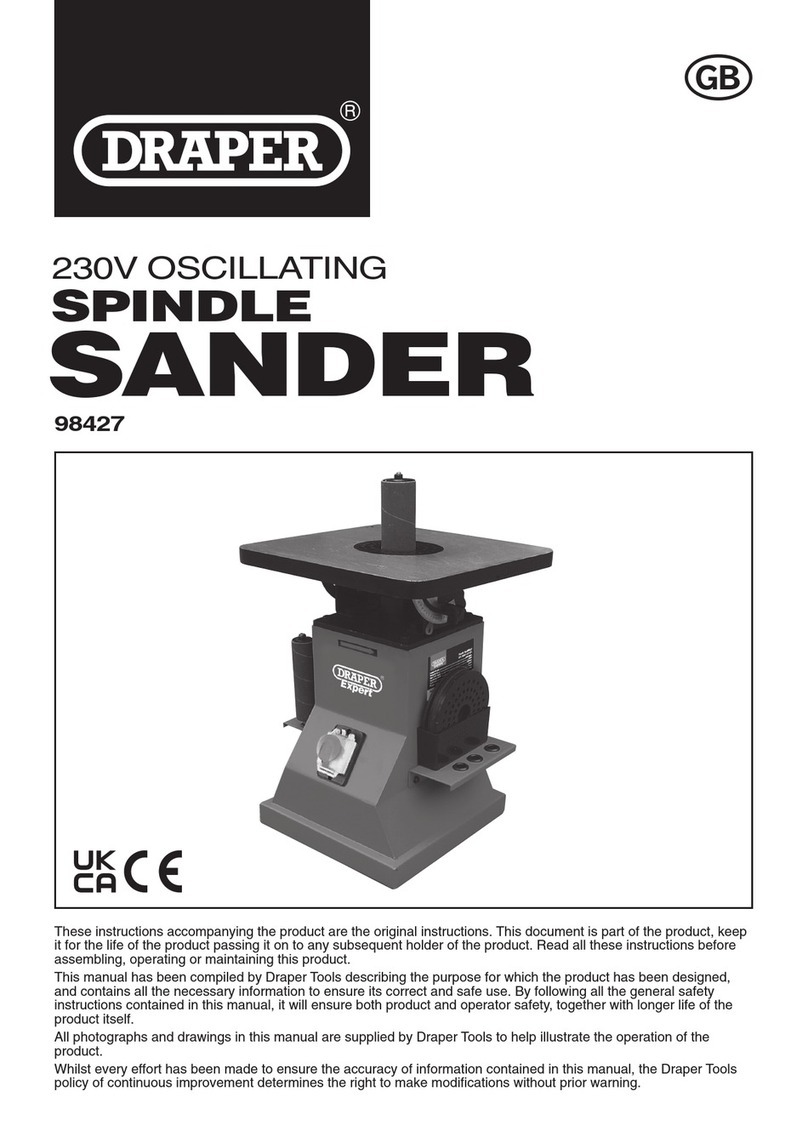
Draper
Draper 98427 User manual
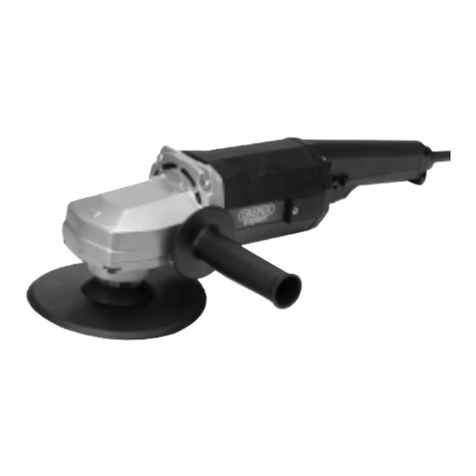
Draper
Draper ANGLE POLISHER & SANDER User manual
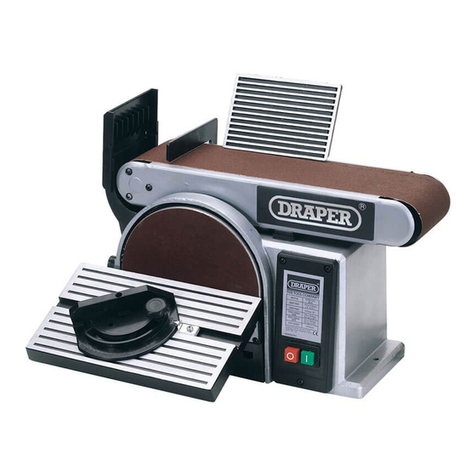
Draper
Draper BDS368 User manual
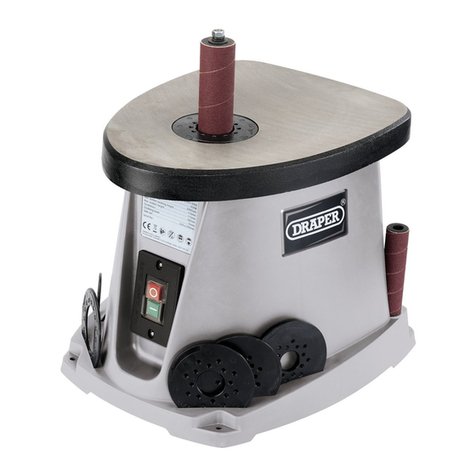
Draper
Draper BBS450A User manual

Draper
Draper 300W Firmware update
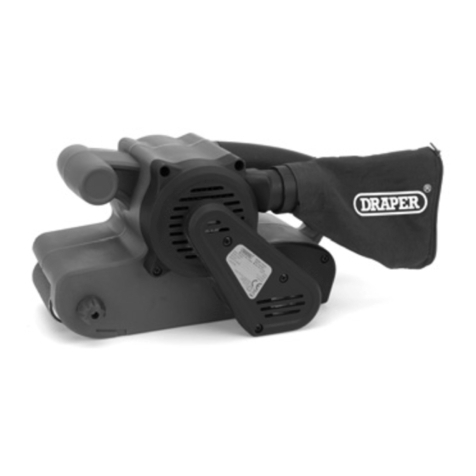
Draper
Draper PT75B User manual
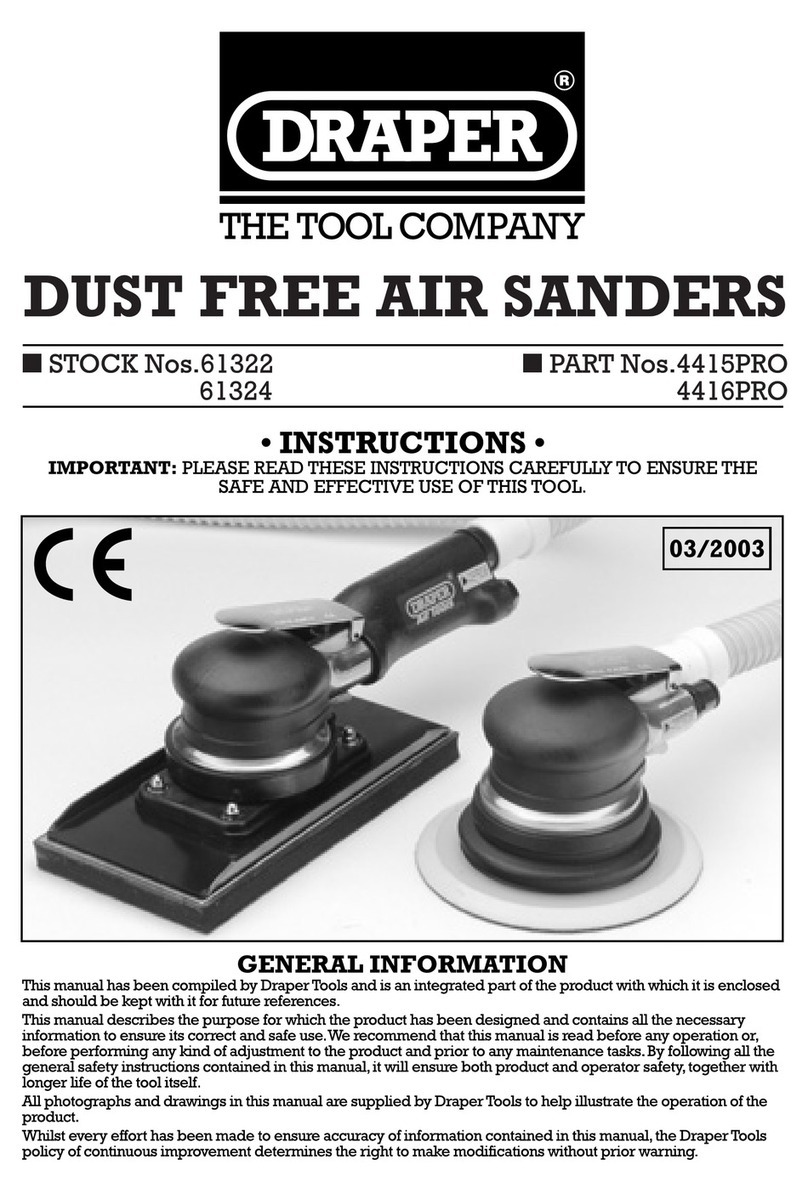
Draper
Draper 61322 User manual
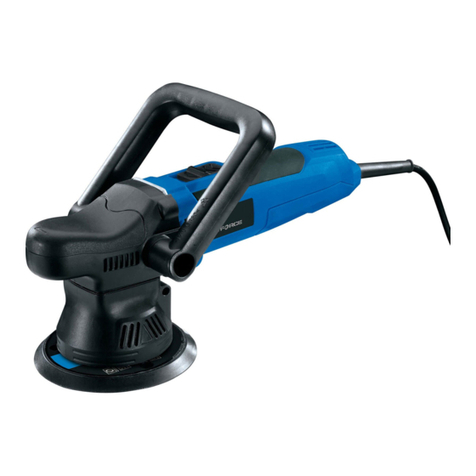
Draper
Draper Storm Force DA650SF User manual
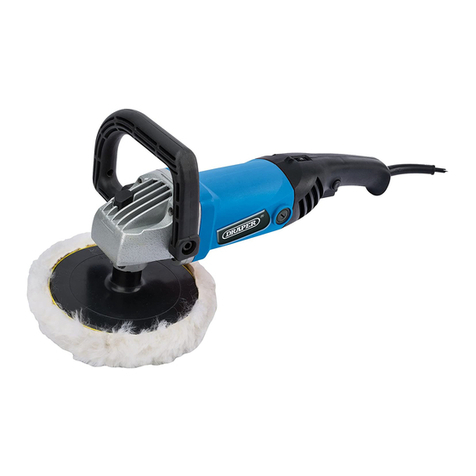
Draper
Draper 53016 User manual
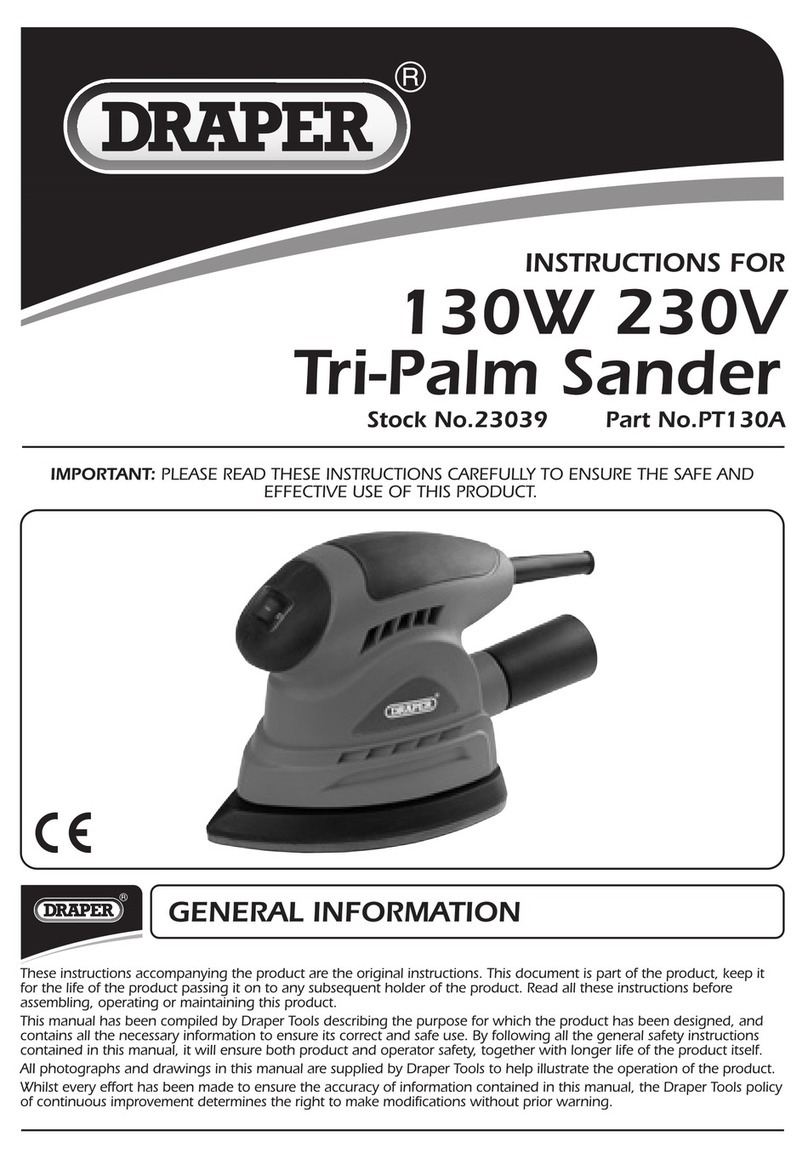
Draper
Draper PT130A User manual
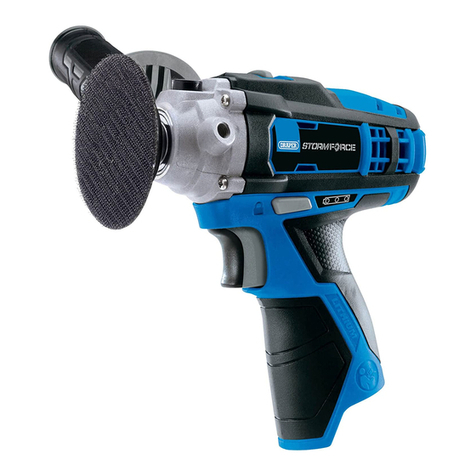
Draper
Draper Storm Force 70453 User manual

Draper
Draper 65084 User manual
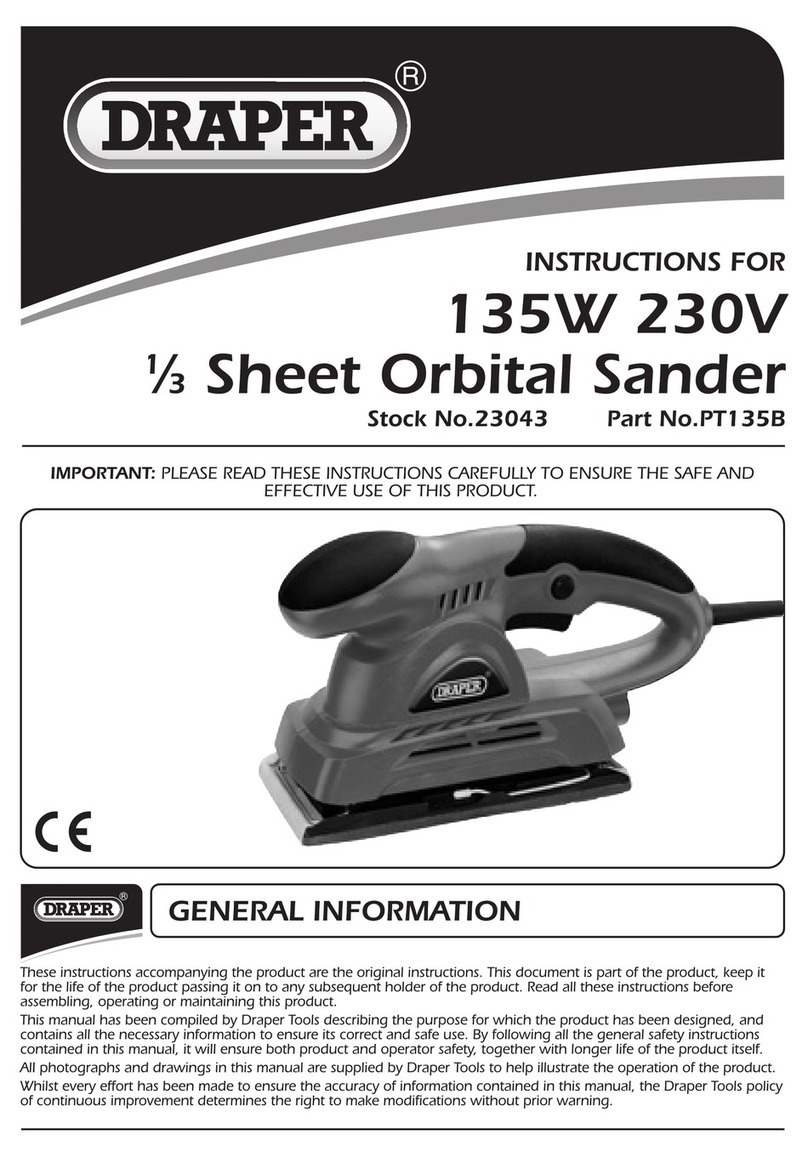
Draper
Draper PT135B User manual

Draper
Draper PT180A User manual
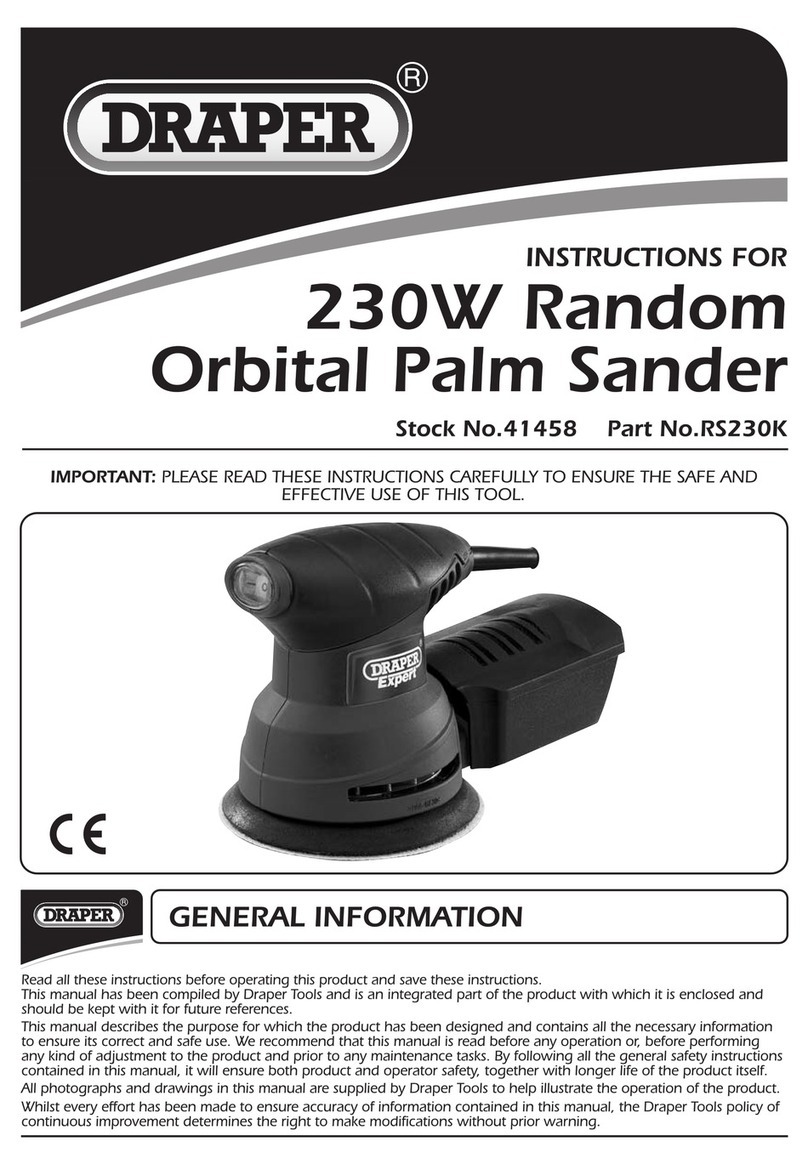
Draper
Draper RS230K User manual
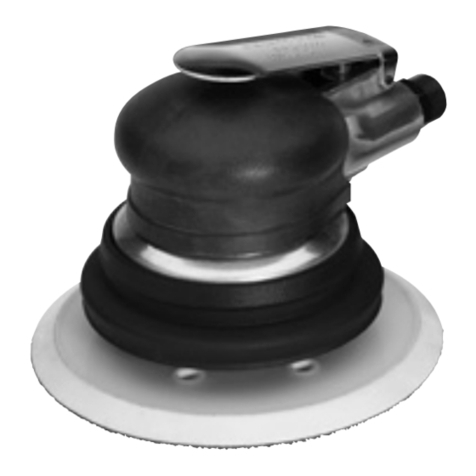
Draper
Draper 4416PRO User manual

Draper
Draper BBS450A User manual
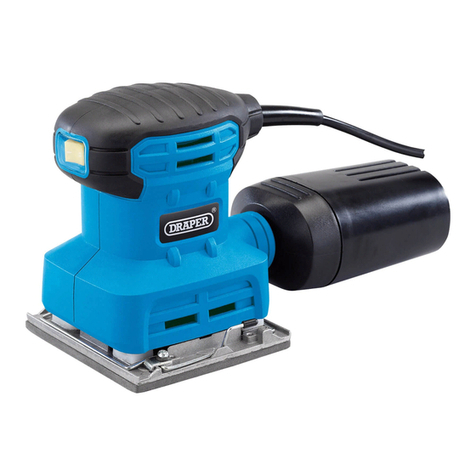
Draper
Draper PT220 User manual
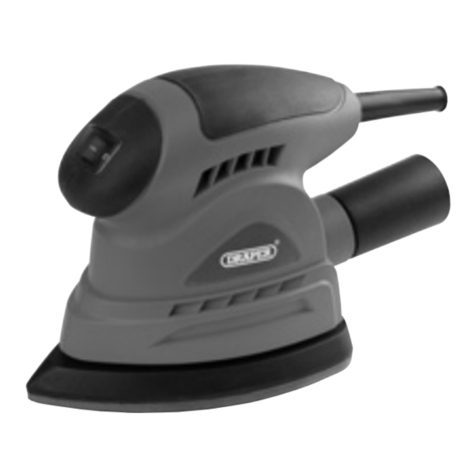
Draper
Draper PT130 User manual

Draper
Draper PT141 User manual

